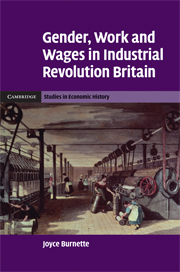Book contents
- Frontmatter
- Contents
- List of figures
- List of tables
- Preface
- Introduction
- 1 Women's occupations
- 2 Women's wages
- 3 Explaining occupational sorting
- 4 Testing for occupational barriers in agriculture
- 5 Barriers to women's employment
- 6 Occupational barriers in self-employment
- 7 Women's labor force participation
- 8 Conclusion
- Appendix to Chapter 3
- Appendix to Chapter 4
- Bibliography
- Index
2 - Women's wages
Published online by Cambridge University Press: 07 August 2009
- Frontmatter
- Contents
- List of figures
- List of tables
- Preface
- Introduction
- 1 Women's occupations
- 2 Women's wages
- 3 Explaining occupational sorting
- 4 Testing for occupational barriers in agriculture
- 5 Barriers to women's employment
- 6 Occupational barriers in self-employment
- 7 Women's labor force participation
- 8 Conclusion
- Appendix to Chapter 3
- Appendix to Chapter 4
- Bibliography
- Index
Summary
It is not easy to account for so striking an inequality; and still less easy to justify it.
F. M. Eden, 1797The strength required for the work performed by men effectively prevents women from being employed in it; and the lower rate of wages for which they work has not had any tendency, therefore, to make them more generally employed.
Alfred Austin, parliamentary investigator, 1843In the last chapter we saw that women and men tended to work in different occupations, though the sorting was not perfect and we find women working in a great range of occupations. This chapter will investigate gender differences in wages. I will first establish the size of the wage gap, and then move on to the question of why it existed. Measuring the size of the wage gap may seem straightforward, but it is in fact complicated because, as we shall see, measurement error in many cases leads to an incorrect assessment of the gap. Understanding the causes of the wage gap is even more difficult because both custom and market forces pushed women's wages below men's wages, making it difficult to determine which was the fundamental cause of wage differences.
Women's wages were clearly lower than men's. Historians generally accept that women's wages were between one-third and one-half as much as men's wages.
- Type
- Chapter
- Information
- Gender, Work and Wages in Industrial Revolution Britain , pp. 72 - 135Publisher: Cambridge University PressPrint publication year: 2008



